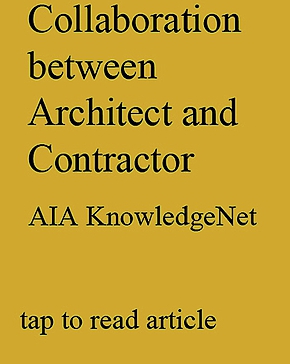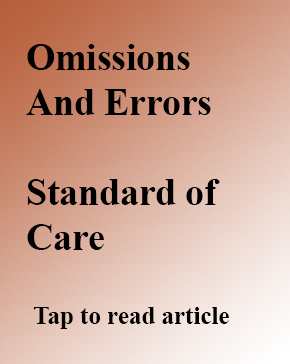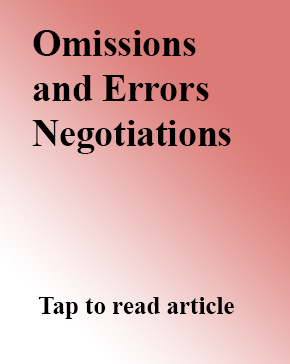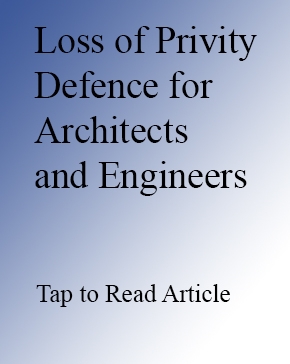Collaboration between Architect and Contractor
By Paul Potts
Introduction
Until the 1970s, architects in the United States were immune to construction lawsuits other than those brought by the owner. This allowed the architect to have a significant role during construction to ensure the design intent was realized and to protect the owner from defective workmanship and deficiencies in products without fear of being sued by the contractor. This immunity broke down when jurists and judges began to question whether it was fair to give architects such complete immunity even where personal injury was involved. To make matters worse, during the 1980s, courts abandoned the traditional exemption architects enjoyed from tort law and began to allow contractors to sue architects based on the tort of negligent misinformation.
The first half of this paper provides a brief history of the loss of the traditional privity defense and the development of a new liability in tort law and an examination of how the American Institute of Architects (AIA) has reacted to these new economic risks. The latter half describes, the benefits of collaboration and the importance of the architect’s participation in the construction project. For the sake of brevity, the focus of this paper is limited to AIA owner-architect agreements and general conditions where the owner has hired a construction manager.
The loss of privity defense
Until 50 years ago, two legal principles gave architects an ironclad defense against litigation brought by parties other than the owner—the Common Law of Privity and its offspring, the Economic Loss Doctrine.
The privity defense was so reliable that few architects carried professional liability insurance until 50 years ago.1 But since then, jurists and judges have chipped away at the privity defense and added tort liability to the mix. The tort of negligent misinformation was allowed to pierce the immunity of privity and the Econominc Loss Rule.
Tort law
Tort law is common law that protects unsuspecting individuals from financial losses due to the unlawful acts of others (e.g., fraud, defamation, or negligence). While tort law can be used to recover financial losses due to criminal acts, it is not criminal law. For a variety of reasons, until 1979, architects were exempt from tort litigation (while other professionals, such as certified public accountants and attorneys, were not).
In 1979, the American Law Institute, a society of around 3,000 jurists established “to promote the clarification and simplification of United States common law and its adaptation to changing social needs,”2 observed that architects’ exemption from tort law was unfair and this needed to be changed by the courts. This recommendation opened the door to a new class of litigation for architects—tort litigation. Lawsuits in tort for economic losses can be brought by any contractor who claims an economic loss due to negligent misinformation in the plans and specifications.
To protect its membership, the AIA responded to these developments in two ways: First, it enhanced its educational program warning architects of the added financial risks. Second, it modified its standard forms of agreement and general conditions to the contract to minimize and more carefully define the architect’s contractual obligations to the owner during construction. But the modifications to the agreement did not provide any new protection from tort litigation.
Modifications to the Owner-Architect Agreement
AIA standard form agreements and general conditions are the most frequently used documents in the world for contracting with architects.3
In 2009, the AIA replaced the B141 CMa-1992 agreement with the B132- 2009 Standard Form of Agreement Between Owner and Architect, Construction Manager as Adviser Edition, and replaced the A201CMa-1992 General Conditions with A232- 2009 General Conditions of the Contract for Construction, Construction Manager as Adviser Edition. The 2009 documents reduced the architect’s responsibility in two significant areas: owner’s representative and standard of care during site visits.
B141CMa-1992 agreement
- Act as representative of the owner during construction: Paragraph 2.6.4 “The Architect shall be a representative of and shall advise and consult with the Owner during construction.”
- Standard of care during site visits: Paragraph 2.6.5 “On the basis of on-site observations as an architect, the Architect shall keep the Owner informed of the progress and quality of the Work, and shall endeavor to guard the Owner against defects and deficiencies in the Work.”
B132CMa-2009 agreement
- The architect is no longer the owner’s representative during construction unless agreed to in a separate document: Paragraph3.6.1.2 “The Architect shall advise and consult with the Owner and Construction Manager during the Construction Phase Services.”
- Standard of care during site visits: Paragraph 6.2.1 “On the basis of the site visits, the Architect shall keep in writing the Owner reasonably informed about the progress and quality of the portion of the Work completed, and report to the Owner and the Construction Manager (1) known deviations from the Contract Documents and from the most recent construction schedule, and (2) defects and deficiencies observed in the Work.”
In the 1992 edition the architect had a central role in the administration of the contract. Terms regarding the architect’s duties and obligations to the owner during construction were quite specific: the architect is the owner’s representative and is charged with the responsibility to visit the site to endeavor to guard the owner against defects and deficiencies in the work.
In the 2009 agreement the architect is no longer identified as the owner’s representative and is not required to endeavor to guard the owner against defects and deficiencies in the work (these services can be added back into the agreement for an extra fee). The architect is only required to report to the owner and the construction manager known deviations from the contract documents and defects and deficiencies observed in the work. This is a lower standard of care and requires less diligence on the part of the architect.
The architect’s withdrawal as the owner’s representative during construction has created a windfall for enterprising companies offering a range of accounting and construction services to the owner. Many of these services provided by third parties are simply shallow imitations of those formerly provided by architects, since they are provided by businesses without the same acumen, knowledge and training that architects have.
How does collaboration survive in the environment?
 There is nothing in the recent AIA standard agreement and general conditions prohibiting architects from discussing the work with the contractor, replying to questions from the contractor or otherwise collaborating with the contractor while at the jobsite, but many architects see overtures from the contractor to discuss the project as traps intended to ensnare the architect in liability claims.
There is nothing in the recent AIA standard agreement and general conditions prohibiting architects from discussing the work with the contractor, replying to questions from the contractor or otherwise collaborating with the contractor while at the jobsite, but many architects see overtures from the contractor to discuss the project as traps intended to ensnare the architect in liability claims.
Professional liability insurance companies typically recommend that their clients not provide services that are not specifically defined in the owner-architect agreement and advise their clients that performing such services exposes them to the risk of not only being uncompensated for their efforts but also not being covered by their insurance.4 This generally discourages collaboration.
If looked at only from the point of view of duties and responsibilities defined in the agreement, why would informed architects provide a service for which they are not compensated and that involves additional financial risk? But there are other points of view, and plenty of good reasons to take prudent risks by closely observing the contractor’s work for compliance with the contract documents and working with the contractor to achieve the design intent.
The architect’s presence at the site
Let’s now look at the benefits to the architect of maintaining an observant presence at the site and forming a collaborative relationship with the contractor. What follows are a few benefits that architects derive from maintaining an informed presence at the site:
- The architect’s presence at the site is good client management. It gives the owner confidence that will come in handy when things go wrong.
- Errors and omissions are disconcerting and damage an architect’s credibility with the owner. However, errors and omissions are more likely to be forgiven if the architect has been observing the construction and, by collaborating with the contractor, identifying mistakes before they are built into the work.
- Contractors notice mistakes in the plans. When they have developed a professional relationship with the architect and are treated more as partners than as adversaries, they are more likely to bring errors in the documents to the attention of the architect. While the prudent architect will document interactions with the contractor relevant to the contract documents, this shouldn’t discourage collaborative and constructive architect-contractor discussions. However, the architect should take care not to give the contractor off-the-cuff, uninformed answers; responses to the contractor’s questions should always be well researched.
- A serious presence at the site is good defensive architecture. There is always a blame game going on at the jobsite. For better or worse, the owner is influenced by on-site gossip, and it affects the owner’s perception of the architect’s performance. When architects have no significant presence at the site, they will get blamed for everything
Construction is a continuation of the design by other means.
It is difficult to say who knows more about the building under construction, the architect or the contractor. Each knows a different aspect of it. But until the contractor builds it, the design is just an idea, just lines and words on paper packed with potential surprises. It is an unavoidable conclusion that the architect and contractor have many good reasons for putting their heads together during construction.
The architect
To their credit, architects have years of academic and professional training, and are licensed by their states to practice their profession. They have spent months developing the design intent and more months selecting products, designing the building, and engineering site improvements and building systems. The architect has a deep knowledge of the project that cannot be matched by any other participant to the construction process. Owners that attempt to economize by building the project without the construction administration services of the architect are putting themselves at a distinct disadvantage.
The architect’s knowledge represents a holistic understanding of the project, making it possible for them to walk the site and spot deficiencies in the work, often without needing to consult the drawings or specifications. As a recent example, I was walking a project site with a project architect when, after just a few minutes, he saw exterior sheathing that should have been fire rated and was not. That kind of knowledge is invaluable to all parties.
The contractor
Contractors have empirical wisdom of the means and methods and tradecraft of constructing a three-dimensional object from a two-dimensional representation of it. This wisdom is at the core of the contractor’s business. Without the contractor’s acumen, the architect’s design could never be realized. But the contractors’ knowledge of the project is of a piecemeal nature, limited to their own trades.
Contractors may have worked on projects like the one currently in design and may even have worked with the same architect on other projects. This background gives the contractor an experiential view of the plans that the architect does not have. Securing the contractors’ services during the design phases and collaborating with them during construction can be an asset to the architect. Contractors are frequently employed during design to monitor the project’s budget and to review the plans for constructability issues.
Construction is the first real test of the design
Construction of a project tests the architect’s design in the real world. It’s no longer just meetings, words, and lines; it a three-dimensional object. When contractors work closely with architects during design, and architects work closely with contractors during construction, the design intent is more likely to be realized.
During construction, if the architect’s representative has established a rapport with the contractor, and helped solve urgent problems, the contractor may be more likely to alert the architect regarding conflicts or possible errors in the documents. However, this collaborative approach doesn’t reduce the importance of architects’ documenting their project-related interactions and discussions with the contractor, should they need to defend themselves later.
Design-build
Design-Build would seem to resolve all the conflicts we have discussed in this paper. The owner contracts with one party, the design-build entity, which represents the designer and the contractor. In many ways, this frees the architect to collaborate with the contractor in an environment that entails less risk. However, this leaves the owner without any independent voice to defend the design intent and guard against defects and deficiencies in the work. Architects are less likely to criticize the work of the contractor if the contractor is paying for their services. This just gets the architect further out of the picture and takes much of the pleasure out of architecture. (On the other hand, no matter who is paying the architect, the architect’s primary responsibility, as a result of being professionally licensed, is to the public.)
Design-build may be appropriate for megaprojects involving, design and construction in one package, but for more modest school projects, for example, it takes away the important oversight role of the architect.
Conclusion
With the demise of the privity defense and increased exposure to tort litigation, the financial risk for architects has increased significantly. In response, the AIA has attempted to shelter its members from the increased liability by minimizing the architect’s duties and responsibilities to the owner during construction.
While these modifications—assuming a judge accepts the premise that the architect is not obligated to be the owner’s representative—do reduce the the architect’s duty to observe the construction on the owner’s behalf, but it does nothing to to ptotect architects from tort litigation. Moreover, they can sever connections between architects and contractors that could be beneficial to architects if handled prudently. Cooperating with the contractor is still the best way to stay on top of errors and omissions and constructability issues an avoid claims by the owner for negligence.
Presentations and conclusions in this article are the result of research and experience as a construction administrator working for owners and architectural firms. Nothing in this paper should be construed as legal advice. Due to the state by state variations of contract law any legal questions should be directed to attorneys in your state of practice. You can reach the author at paulpotts1@comcast.net or leave a comment at www.linkedin.com/in/pauljpotts
References
- These defenses were so effective that, only a number of decades ago, many architects did not carry professional liability insurance. AIA Trust: Contractor Terminations
- American Law Institute. Wikipedia
- XL Catlin’s Contract eGuide “Professional Services Agreements: A Primer 3
- “Stepping outside your scope when it comes to construction administration is a risk and may leave your firm vulnerable to claims. Likewise, dealing directly with contractors without remembering your relationship to the owner (“the law will treat the architect as the owner’s agent”) is also risky.” A/E ProNet CONSTRUCTION ADMINISTRATION LIABILITY RISK AVOIDANCE March 14, 2012 Page 3






